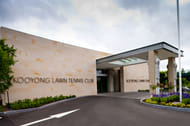It is all about tennis in Melbourne right now
Glen Iris is a quiet neighbourhood to the east of Melbourne’s central district. It is one of the city’s many pleasant, leafy suburbs. It also happens to be a 20-minute train ride from Melbourne Park, home of the gladiatorial tennis arenas of Rod Laver, Margaret Court and Hisense.
Today, I decided to catch a train to Melbourne Park, three days before the Australian Open begins. The intent is to catch up on some qualifiers, walk around the grounds, take in the calm before the storm. I am soon to realize that in Melbourne, you do not need to go to the tennis, the sport is always around you.
As I walk to my train station in Glen Iris, I see the local café’s TV tuned in to a rerun of last night’s ATP tour happenings in Sydney. Bernard Tomic is slicing and dicing from the baseline as usual, in the last warm-up tournament before his home Grand Slam. I can hear the commentator drawl away, “Bernard needs to be more aggressive, needs to stop pushing the ball in, if he is to have any chance this year.” His strident emphasis on the ‘needs’ makes the commentator sound more like an anxious father worrying about a wayward son.
Tennis courts galore
At the train station, a notice pinned up by the local tennis club catches my eye. The neighbourhood tennis club is a ubiquitous phenomenon in Melbourne. Every suburb worth its salt has at least a couple of tennis clubs, each with at least four or five courts. It remains a hard task here to walk past more than a couple of streets without hearing the soft ‘puck’ of tennis racket making connection with ball. I see that this particular notice is advertising the club’s array of services, which include cardio tennis camps, private lessons, group lessons, restringing services, grip sales, among a host of others.
It also mentions the option of ‘social match competition, courts available at $10 per hour, excluding light morning breakfast’. I think to myself that $10 is a good deal. I also find myself wondering how ‘social’ a ‘competition’ can be, and how much the light morning breakfast would cost.
The Kooyong tennis club
I catch my train, and settle down for the 20 minute ride downtown. A rush of green foliage speeds past me, interspersed with views of the muddy Yarra river, as it snakes its way towards Melbourne Park as well. The vegetation suddenly breaks away, and a glorious view of row upon row of green grass courts appears. I know this is the Kooyong Lawn Tennis Club, an integral part of Australian tennis history. Beginning in 1972, this venue played host to the Australian Open for a continuous period of 16 years. Today, it feels strange to picture the year’s first Grand Slam being played on grass. But that is how it remained until, in 1988, the tournament outgrew Kooyong’s capacity, and was moved to the hard courts of Melbourne Park.
Today, Kooyong’s international tennis legacy is retained by the Kooyong Classic, an exhibition men’s hard court tournament played in the week immediately preceding the Australian Open. In fact, as my train rushes by, I can see the farthest couple of courts covered in white tents. I know that the exhibition event is underway on the centre court today. I realize even at that moment, the likes of defending champion Kei Nishikori, Richard Gasquet and Gilles Simon are sweating it out on the Kooyong courts, paying tribute to history in a diminished version of the Club’s glory days.
The Happy Grand Slam
At the next station, an elderly, white-haired lady shuffles on board, and settles into the seat next to me. “ I like your shirt”, she says suddenly, with a conspiratorial smile. I realize I am wearing a Sportskeeda t-shirt which proudly declares, “Less Work, More Tennis”. Soon, we are in the middle of an enjoyable discussion about the sport and its various characters. Isn’t Federer such a gentleman? What do you think of Kyrgios? Who do you think will win this year? The old lady doesn’t think she will make it to the tournament this year (“too old to run around in the sun”), but she will definitely be following it on television.
Before I know it, we have reached Richmond, the stop where I need to exit. I exchange a warm farewell with my new friend, and stepped out into the hot sun. To my right, rises the imposing grey edifice of the Melbourne Cricket Ground. To my left, I see blue flags bearing the Australian Open logo, fluttering in the breeze. That must be my destination.
As I walk in the direction of the flags, I think I begin to understand how integral a role tennis plays in everyday Melbourne life. Everyone here knows about it, talks about it, quite a few even play it. It doesn’t evoke the kind of fan-based support that, say, Australian Rules Football, or even cricket, does here. But tennis goes deeper, into the very fabric of society. It is not as much a sport, as it is a way of life here. Perhaps, this is why the people of Melbourne are proud of hosting the Australian Open. Perhaps, this is what sets the overall tone of the tournament – an open, relaxed, happy atmosphere. Perhaps, this is why it is known as the Happy Grand Slam.

